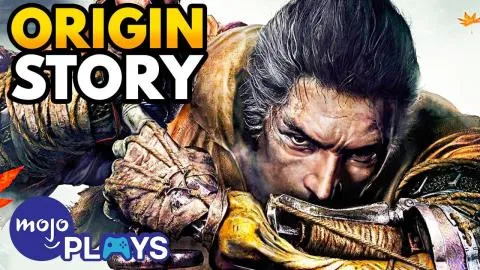Origin of Sekiro the One-Armed Wolf

“Sekiro” is set during a very specific time in Japanese history, the Sengoku period, or the Warring States period. This era lasted for almost 150 years, going from the end of the Onin War in 1477 up until the establishment of the Tokugawa Shogunate in 1601. It started because of disagreements in the succession of the Ashikaga Shogunate, a very weak government whose shogun let many of the era’s powerful warlords, or “daimyo”, amass power and strength without doing anything to stop them. When there was no easy heir for the Ashikaga dynasty, fighting broke out between the daimyo, with all of them wanting to claim as much of Japan as possible. This became the Sengoku period, a seemingly-never ending era of violence, bloodshed and conflict; there was nobody alive to see both the beginning and the end of this era.
It’s this background of eternal war and death that Sekiro is born into, adopted on the battlefield by an imposing shinobi named the Owl who cuts his face and gives him his scar. Owl becomes Sekiro’s father, who abides rigidly by the Iron Code and teaches Sekiro to do the same. Sekiro takes the name Wolf and is trained as a shinobi, an elite ninja who later becomes the loyal bodyguard of Lord Kuro, the Divine Heir. Shinobi have a combat advantage by focusing on versatility, mastering many different fighting techniques, which is why Wolf wields both his katana and the shinobi prosthetic. At some point before the beginning of the game, Kuro gives Wolf the Dragon’s Heritage, the gift of immortality granted to Kuro by his blood, which is how he survives his fatal injuries after Genichiro cuts off his left arm.
But this is where the origins get muddy, thanks to the game’s themes of rebirth and immortality, as well as Buddhism. It was the Ashikaga Shogunate who popularized Buddhism in Japan before the beginning of the Sengoku period, and Buddhist teachings are invoked throughout “Sekiro”. Specifically, the Buddhist belief that life is a struggle and people can only reach nirvana by understanding this and shedding their attachments to the material world and mortality. This is why immortality is treated as a curse throughout “Sekiro”, a cause for great corruption as the various antagonists – such as Genichiro and the Owl – want to use the Dragon’s Heritage to create an immortal army. The game’s best endings involve Kuro and Wolf being freed from immortality, namely the Purification ending where Wolf dies for good and Kuro is allowed to live his life normally, without his burden.
The idea of eternal rebirth is best explored by the main good ending, however in the Immortal Severance ending, Kuro dies for good and Sekiro becomes the new one-armed, ex-shinobi sculptor, who vows to pass the shinobi prosthetic onto the next warrior who crosses his path. There are some fan theories that Sekiro and the Sculptor are the same person, the latter being a past version of Sekiro who wasn’t able to end his immortality. This means that until Sekiro archives the Purification ending, he is doomed to continue this cycle over and over again, becoming the Sculptor we meet early on in the game.
The conflation of Sekiro and the Sculptor makes even more sense when the Sculptor explains that his arm was cut off by Isshin many years earlier, to stop him being overwhelmed by shura. Shura is a word with no strict English translation, but roughly means giving in to bloodlust and perpetuating conflict and violence with no remorse or reprieve – the driving force beind the Sengoku period’s daimyo. “Sekiro’s” bad ending shows Wolf giving in to shura by murdering the Owl after he betrays Kuro. In this ending, Wolf becomes the demonic Shura, and goes on a violent rampage through Japan for many years. Seeing as Genichiro cuts off Sekiro’s arm, like Isshin cut off the Sculptor’s arm, and since both Sekiro and the Sculptor say they trained with the Owl when they were younger, this adds even more credibility to the theory. But the Sculptor’s shura is not curbed by the loss of his arm, as he becomes the optional “Demon of Hatred” boss-fight, just like Sekiro can also give in to shura despite having his arm cut off. In both cases the descent into shura is optional but the potential is there.
Much of Sekiro’s life remains a mystery, and it’s hard to say whether there is much more to him than being a noble shinobi sworn to protect the Divine Heir. Where he actually came from before being adopted by the Owl is unknown, and equally, where he ends up depends on the player. But he’s a character you can understand, get invested in, and you’ll come to care about him even as he’s killed and repeatedly resurrected because of the game’s gruelling difficulty.
